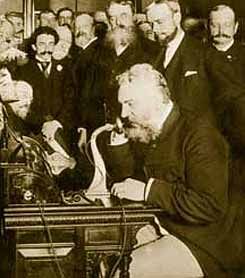In the first part of this series, we discussed how the words "Internal Communication" led to the now common term, Intercom. We also talked about how the first intercom systems were known as voice tubes; tubes that carried voices acoustically. Although these were very crude systems compared to later electrical products, they did actually work. Some types of voice tubes are still in use today.
Like many other technologies, electrification changed intercom products radically. Before the electrical intercom could exist, one invention had to proceed it.
The telephone.
 |
| Bell making the first telephone call |
When Alexander Graham Bell sat in one room in his Boston home, raised a transmitter tube to his mouth and then said, "Mr. Watson, come here. I want to see you", he was talking from that room down to his assistant in the basement, Thomas Watson. Watson, an engineer and employee of Bell's, once claimed that Bell had spilled battery acid on his leg and was genuinely calling for help. However, Watson later said that he could not be certain if this took place during the first test or in subsequent research. In any case, Bell documented the event in his journal on March 10th, 1876, making the first words spoken over what would later become the telephone, revolutionizing communications around the world. One of the first systems ever patented was built by the Kellogg Switchboard and Supply Company in 1894. It's main purpose was for use in apartment buildings. Some early apartment buildings had a pull-wire, then later electrical, signaling system. A prospective visitor would pull a handle, or push a button on a panel, which would then signal the tenant that someone wanted inside. However, because they couldn't see or talk to who was signaling them, they ran the risk of letting in someone they didn't know, like a burglar.As is true today, the more upscale apartment buildings in major cities had doormen to guard the building. Prior to the intercoms being available, these men would have to lock out the person asking for entry and go up to the tenant's apartment to ask if the tenant wanted to see the visitor or not. As apartment buildings became larger, this process became frustrating to both the tenants and the visitors.
One of the first systems ever patented was built by the Kellogg Switchboard and Supply Company in 1894. It's main purpose was for use in apartment buildings. Some early apartment buildings had a pull-wire, then later electrical, signaling system. A prospective visitor would pull a handle, or push a button on a panel, which would then signal the tenant that someone wanted inside. However, because they couldn't see or talk to who was signaling them, they ran the risk of letting in someone they didn't know, like a burglar.As is true today, the more upscale apartment buildings in major cities had doormen to guard the building. Prior to the intercoms being available, these men would have to lock out the person asking for entry and go up to the tenant's apartment to ask if the tenant wanted to see the visitor or not. As apartment buildings became larger, this process became frustrating to both the tenants and the visitors.
 |
| Early Kellogg Phone |
The Kellogg system added a telephone-type circuit to the signal panels. An earpiece and mouthpiece resembling the old-fashioned candlestick telephones allowed the tenant to talk to the visitor directly, instead of having the doorman run up and down to ask the tenant in person.In the late 1930's, an engineer named Allan C. Bernstein started a company called Adams Laboratories that took the apartment intercom idea into the workplace. Ultimately, Adams Laboratories became the manufacturing arm of Executone Corporation, with Bernstein as President. The first product was a simple two-station system, called the "boss-to-secretary" system. This migrated into further point-to-point wired systems, including one of the first "patient-to-nurse" hospital communication systems ever used. Over his lifetime, Bernstein developed and held many patents until his death in 1987.
 |
| RMS Queen Mary's Loudaphone |
One unique intercom system for use in noisy environments was made in England in the 1930's. Called the Loudaphone, it was installed in places with high background noise, such as trains or ship engine rooms. For example, the RMS Queen Mary had a Loudaphone system in use in the engine room areas.After the Bell System monopoly was established in the early 1920's, the local telephone companies owned by Bell, then later American Telephone and Telegraph (AT&T), were the only convenient source of equipment and services for regular land-line telephone systems. This gave them a perfect opportunity to also be the provider of intercom systems.
 |
| Multiple desk phone intercoms |
In old movies from the early part of the twentieth century, some of the scenes set in offices show a desk with two or three phones. Many times, one of the phone would be a part of an intercom system within the building. It wasn't until more sophisticated systems came along that the phones used for outside lines also had an intercom tied to them. However, not all businesses took advantage of this capability. Today, this is still the case.As time passed, the needs of the marketplace caused manufacturers to make a lot of progress on new features. Speaker-based intercoms, such as those used in naval ships in WWII, became common in the commercial world. Since these operated like a speakerphone, they didn't require a handset. More than one person at a time could participate in the conversation. Noise-cancelling circuits for loud areas, public address capabilities, and other similar modern features made it easier for end users to find a system that suited their needs.
 |
| Wires, wires and more wires |
One large cost factor in intercom installation was the wiring that had to be run inside the building. Pulling wire is extremely labor-intensive and it can be the most expensive part of an installation. To help with this, manufacturers came up with wireless systems that function like speakerphones, but use radio frequencies instead of wiring. Another unique solution that was developed became know as a Powerline system. A Powerline is when the intercom hardware uses the wiring that provides power to the outlets as a path for the signal.
In our next installment, we'll talk about the current state-of-the-art intercom technology and address two of the largest users of intercom products - the entertainment and broadcasting industries.
In case you missed Part 1 of this series:
Part 1: Totally Tubular: A History of the Development of the Intercom
 |
Paul Black is a freelance writer and broadcast engineer in Northern California. He holds a Certified Professional Broadcast Engineer certification from the Society of Broadcast Engineers and an FCC Lifetime General Class Operator License. He is a licensed amateur radio operator (call sign N6BBZ) and has worked for several broadcast companies, including Bonneville Broadcasting, RKO General Broadcasting, and CBS Television. Visit his website at www.paulblackcopy.com.
|
Related Articles ---------